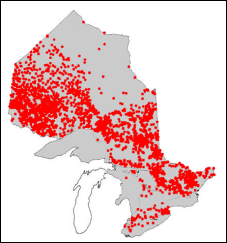Walleye
Information about the Walleye (Sander vitreus), a cool-water fish native to Ontario.

Species image (Illustration Credit: U.S. Fish and Wildlife Service)
What it looks like
- Large, elongated fish
- Back is olive-green to brown; sides paler with yellow flecks
- No distinct blotches or bands on adults
- White tip on lower tail fin
- Spiny and soft dorsal fins separated
- Large mouth extends below back edge of eye
- Large teeth
Size
- Typical length: 35.5–58.4 centimetres (14-23 inches)
- Typical weight: 0.68–1.36 kilograms (1.5-3 pounds)
- Ontario record: 10.1 kilograms (22.3 pounds)
Similar fish
Where it's found

Species distribution map (modified from Mandrak and Crossman, 1992)
Range
- throughout Ontario
- especially common in the Great Lakes basin and Northern Ontario
- use Fish ON-Line, an interactive mapping tool, to find specific lakes and rivers
Habitat
- a range of river and lake conditions
- from cold, clear water to warm, weedy and stained water
- soft mud bottoms to flooded timber, rubble or bedrock
- preferred cover – weed, wood, rock
Angling Tips
- walleye avoid light—best times to fish are morning and evening, and cloudy or overcast days
- take almost any bait or lure in spring, and feed well in fall
- more challenging to catch in summer
- cast or troll with spinners or minnow-imitating plugs
- troll with worm harness rigs of spinners and beads
- still-fish, drift or troll live baits on slip-sinker or "bottom-bouncing" rigs
- ice fish with jigs, jigging spoons or minnows
Common Baits
- jigs tipped with soft plastics, live bait or bucktail
- minnow-imitating plugs
- minnows, earthworms, crayfish
Updated: September 07, 2023
Published: July 18, 2014